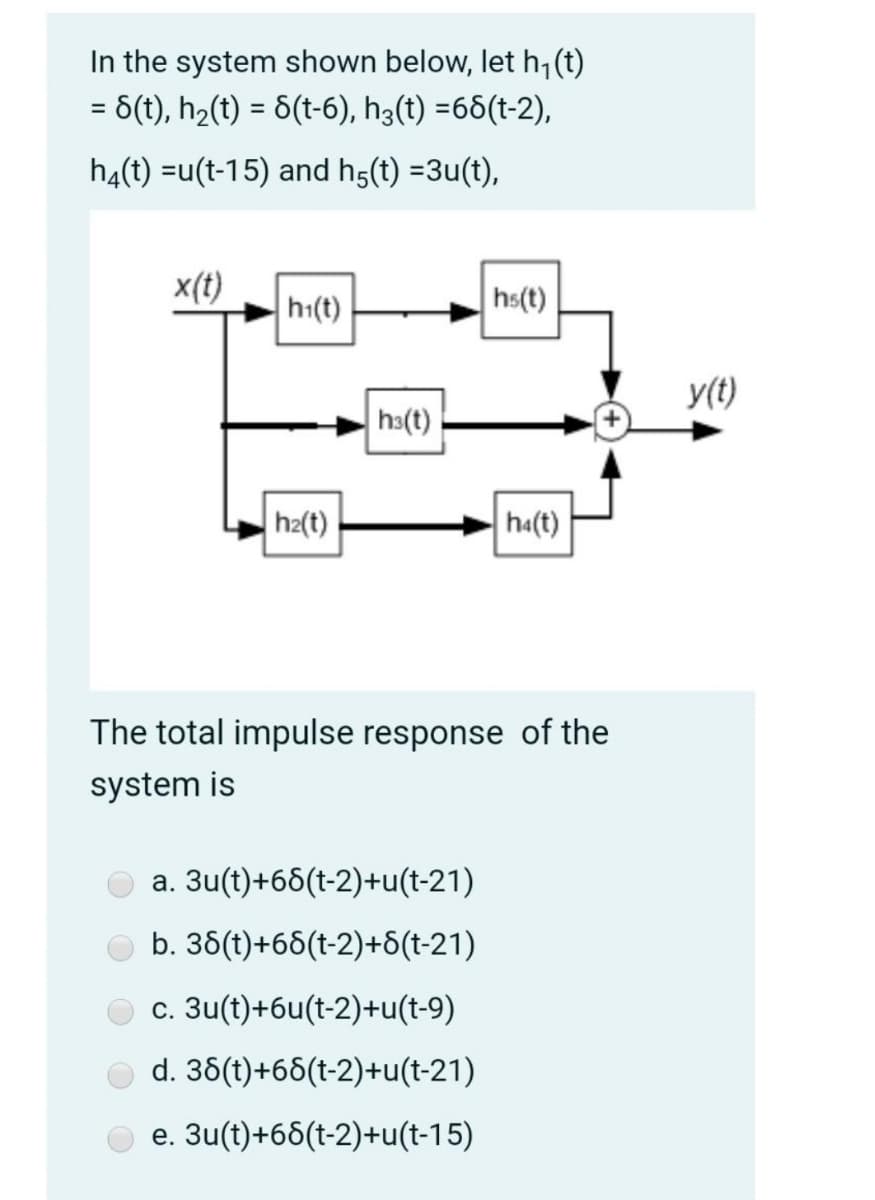In the system shown below, let h,(t) = 6(t), h2(t) = 6(t-6), h3(t) =65(t-2), %3D %3D h4(t) =u(t-15) and h5(t) =3u(t), x(t) ht(t) hs(t) y(t) hs(t) ha(t) ha(t) The total impulse response of the system is a. 3u(t)+66(t-2)+u(t-21) b. 36(t)+66(t-2)+5(t-21) c. 3u(t)+6u(t-2)+u(t-9) d. 36(t)+66(t-2)+u(t-21) e. 3u(t)+68(t-2)+u(t-15)
In the system shown below, let h,(t) = 6(t), h2(t) = 6(t-6), h3(t) =65(t-2), %3D %3D h4(t) =u(t-15) and h5(t) =3u(t), x(t) ht(t) hs(t) y(t) hs(t) ha(t) ha(t) The total impulse response of the system is a. 3u(t)+66(t-2)+u(t-21) b. 36(t)+66(t-2)+5(t-21) c. 3u(t)+6u(t-2)+u(t-9) d. 36(t)+66(t-2)+u(t-21) e. 3u(t)+68(t-2)+u(t-15)
Power System Analysis and Design (MindTap Course List)
6th Edition
ISBN:9781305632134
Author:J. Duncan Glover, Thomas Overbye, Mulukutla S. Sarma
Publisher:J. Duncan Glover, Thomas Overbye, Mulukutla S. Sarma
Chapter6: Power Flows
Section: Chapter Questions
Problem 6.15P
Related questions
Question

Transcribed Image Text:In the system shown below, let h,(t)
6(t), h2(t) = 8(t-6), h3(t) =66(t-2),
%D
%3D
h4(t) =u(t-15) and h5(t) =3u(t),
x(t)
h1(t)
hs(t)
y(t)
hs(t)
h2(t)
ha(t)
The total impulse response of the
system is
a. 3u(t)+66(t-2)+u(t-21)
b. 36(t)+68(t-2)+6(t-21)
c. 3u(t)+6u(t-2)+u(t-9)
d. 36(t)+66(t-2)+u(t-21)
e. 3u(t)+66(t-2)+u(t-15)
Expert Solution
This question has been solved!
Explore an expertly crafted, step-by-step solution for a thorough understanding of key concepts.
Step by step
Solved in 2 steps with 2 images

Knowledge Booster
Learn more about
Need a deep-dive on the concept behind this application? Look no further. Learn more about this topic, electrical-engineering and related others by exploring similar questions and additional content below.Recommended textbooks for you

Power System Analysis and Design (MindTap Course …
Electrical Engineering
ISBN:
9781305632134
Author:
J. Duncan Glover, Thomas Overbye, Mulukutla S. Sarma
Publisher:
Cengage Learning

Power System Analysis and Design (MindTap Course …
Electrical Engineering
ISBN:
9781305632134
Author:
J. Duncan Glover, Thomas Overbye, Mulukutla S. Sarma
Publisher:
Cengage Learning